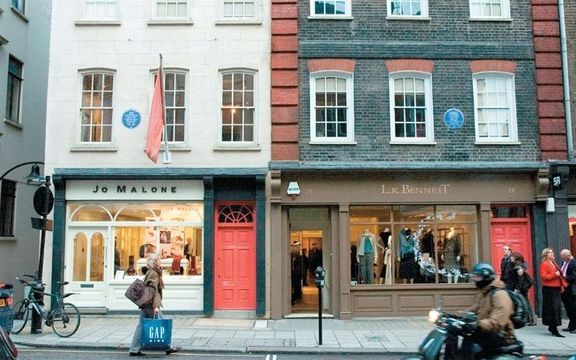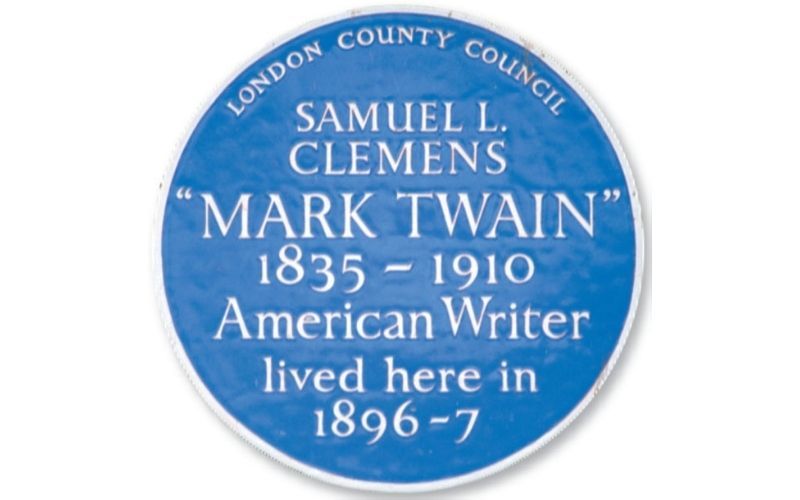
London’s blue plaque scheme sprinkles historical markers around the city to mark where famous and historical people were born, lived or worked.
Dotted around London, like historical chickenpox, are special blue signs that mark a home or workplace of some very famous and very dead people
Leaving a mark at the second floor
Retracing the footsteps of historical figures creates a special connection with their lives. To see a landscape or visit a building that informed a favorite work or historical moment can draw you into it in a surprising manner.
London’s blue plaque scheme, which sprinkles historical markers around the city to mark where famous and historical people were born, lived or worked, has been running for more than 140 years and is the oldest such plan in the world. The scheme is not unique: indeed, in London itself, a number of other programs mark sites of interest to groups such as the Dead Comics Society, and several boroughs acknowledge local notables with colors that distinguish them from the ubiquitous blue plaques.
Currently, there are around 850 blue historical markers throughout London. Naturally, the majority mark sites associated with the great and the good of British society. However, some 20 markers celebrate notable and historical Americans who have, for a time, found a home or workplace in London.

Artistic Memorials
While countless Americans have lived in London over the years without a historical marker, the majority of those whose fame is marked have come from the arts and literary worlds.
With “This is London,” Ed Murrow started his famous radio reports from wartime Britain. His address in Fitzrovia shows where he took shelter between reporting the Blitz. A library shelf of American writing talent—Mark Twain, Nathaniel Hawthorne, Washington Irving, Henry James, Herman Melville, Ezra Pound and Sylvia Plath—demonstrates how important London’s literary atmosphere has been in nurturing American writing talent from George III’s reign to the Swingin’ Sixties.
It is not just the printed word: Seeking inspiration, James Whistler brought his easel and paints to an address in fashionable Cheyne Walk in Chelsea, famously painting Arrangement in Grey and Black: The Artist’s Mother while living in London. Next to a house in Brook Street, Mayfair where George Friedrich Handel once lived is a marker commemorating where Jimi Hendrix lived before his death in 1970.
It is not, however, only the artists who are acknowledged in London. Two inventors, Samuel Morse and Benjamin Franklin are marked. Historian Henry Brooks Adams is recognized, while retailer Harry Selfridge of the eponymous store is remembered in Mayfair.

Following controversial U.S. ambassador Joe Kennedy at the court of St. James may not have been the easiest foreign posting, but at least John G. Winant, U.S. ambassador from 1941-46, got a blue plaque for it. The eighth president, Martin Van Buren, also had an address in London.
Interestingly, when the idea was initially mooted back in the 1860s, one of the first names considered was Benjamin Franklin, less than a century after he had lived in London. Proposed in 1863 in the House of Commons, the scheme for historical markers was set up in 1866 by the Royal Society of Arts.
Other early names considered for memorials were David Garrick and Lord Nelson. The honor of the first plaque went to the poet Lord Byron at his birthplace, 24 Holles Street, Cavendish Square, later demolished in 1889.
In 1879, the Society of Arts came to an agreement with the Corporation of the City of London that the latter would erect plaques in the square mile, which is why there are no blue plaques in the City.
Since 1986, the historical restoration agency English Heritage has managed the blue plaques scheme and bases its selection criteria and processes on those developed by the London County Council. English Heritage’s rules state that the person commemorated must have been dead for 20 years or the centenary of their birth must have passed.
While English Heritage is convinced associating a site with a past notable can only add pounds to its value, the owners of the chosen building still have to give their consent to the blue plaque.
Unmarked Americans
Given the rules of English Heritage, what other U.S. citizens currently or historically associated with London might be worth a plaque in the future? Actor Kevin Spacey has done a great deal for the Old Vic Theater in his time in London. Californian Dennis Severs took an 18th-century house and created live theater out of historical re-enactment in Spitalfields. Perhaps Elizabeth Rosemond Taylor, born at her parents home at 8 Wildwood Road in Hampstead Garden Suburb, might one day be honored?
John Steinbeck settled in at 116 Piccadilly in 1943 to report the war. The dust from another war had just settled when John Adams resided in Grosvenor Square in 1785 as the first minister plenipotentiary to Britain. It may have been a trifle uncomfortable that on the opposite side of the square lived Lord North, British prime minister during the Revolution.
The presence of General Eisenhower in the neighborhood around 160 years later was probably easier.
One American whose life in London may have been among the most dramatic was Wallis Warfield Simpson, the twice-divorced American for whom King Edward VIII would renounce his throne. Memories of her can be found a few blocks north of Oxford Street, where the king, then heir to the throne, would drop in at her apartment on George Street.
Needless to say, the honoring blue plaques are spread across the metropolis, often near a second-story window. As you are walking around the city from Bloomsbury to Westminster, just look up.
*Originally published in 2018. Updated in 2023.





Comments